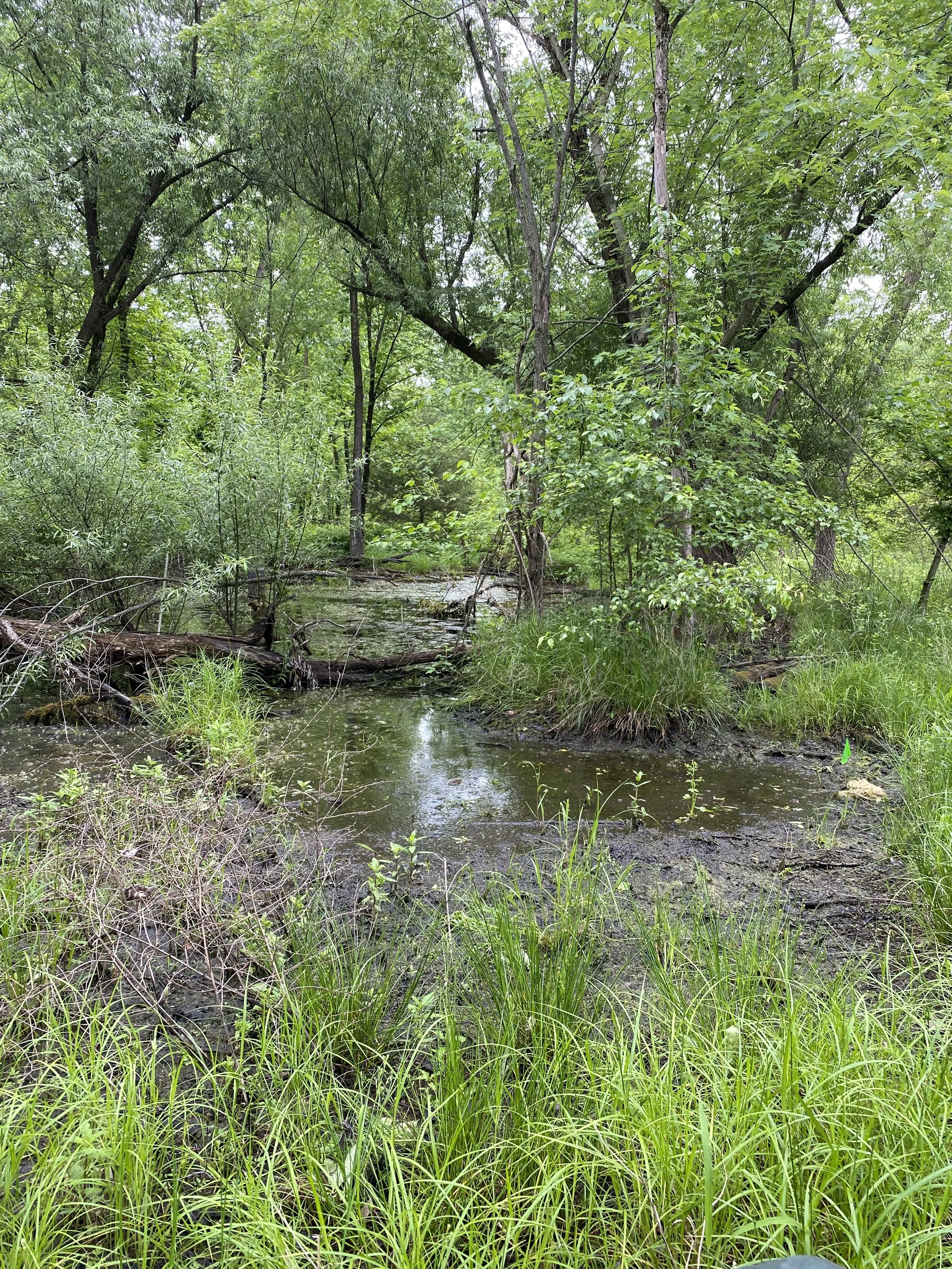Stop 6: Vernal Pool
This page includes a self-guided tour about the vernal pool habitat on Kingman Island.
This content is shared through audio files, written transcripts, and ASL videos (coming soon). We have content designed for “all ages” (which is appropriate for adults and youth alike) or “youth” (which are especially tailored for youth). Click the links below to jump to the section of your choice or scroll down the page to explore all options.
English (All Ages)
Voiced by Damien Ossi, DOEE and Daniel Connor, DOEE
Transcript
Here is a habitat that transforms dramatically with each season. Vernal pools, stemming from the Latin root “ver” which means Spring, are aptly named. In the Spring, this ephemeral pool comes to life with a symphony of amphibian activity. A spring peeper chorus of peep-peep calls marks the beginning of this tiny frog’s mating season. In the still waters of the vernal pool, they gather to mate and lay their eggs. Since this shallow pool will dry up in the heat of Summer, fish cannot live here, so the eggs and tadpoles are safe from being eaten by those predators.
This pool in particular has been home to five of the District’s 14 frog and toad species as well as the more elusive spotted salamanders. If you are visiting in the Spring, stroll along the muddy banks, keep an eye out for slimy egg masses clinging to submerged vegetation. These gelatinous orbs are the future generation of amphibians, patiently awaiting the moment when they will hatch into tadpoles and begin their own journey.
So take a moment to immerse yourself in the wonder of springtime at the vernal pool. Listen for the frog calls and chirps of familiar birds, see if you can identify the sounds. Come back throughout the year and take note of the changes of this unique habitat, and what other critters may be calling it their home.
Vernal pools are an indicator of climate change. Extreme heat and low drought can affect the duration of how long water remains in these habitats. In turn, the species dependent on them are at risk of losing precious breeding ground. Losing biodiversity disrupts the food web and reduces ecosystem resilience.
English (Youth)
Voiced by Martin Noyd, DOEE
Transcript
Something is fishy about this site. Actually, what’s strange is that there are no fish here. That’s because this site is a vernal pool, for part of the year there is water and for the rest of the year, it dries up and there is no water. A fish can’t survive without water, but other animals can and depend on this type of habitat.
Amphibians like frogs, toads, and salamanders start out their life as tadpoles with gills to breath under water and as they grow into adults, they lose their gills and breath air. The vernal pool is a perfect place for the eggs to hatch and tadpoles to grow up because there are no fish to eat them! This wetland is a very special home to all types of frogs, but the wood frog and spotted salamander need to lay their eggs in a vernal pool instead of another other type of water. That makes vernal pools a key habitat for supporting species that make up important parts of the food web.
What time of year are you visiting the vernal pool and what do you notice? When do you think it will start to look different? Do you see or hear frogs calling or is the wetland dry? Come back again to find a new discovery.
Español (Todas Las Edades)
Con la voz de Xochitl Montano-Soriano, DOEE
Transcripción
Este es un hábitat que se transforma dramáticamente con cada estación. Las charcas estacionales, que provienen de la raíz latina “ver” que significa primavera, tienen un nombre muy apropiado. En primavera, esta charca temporal cobra vida con una sinfonía de actividad de anfibios. Un coro de “peep-peep” de las ranitas de primavera marca el comienzo de la temporada de su apareamiento. En las aguas tranquilas de la charca estacional, se reúnen para aparearse y poner sus huevos. Dado que esta charca poco profunda se secará con el calor del verano, los peces no pueden vivir aquí, por lo que los huevos y los renacuajos están a salvo de ser devorados por esos depredadores.
Esta charca en particular ha sido el hogar de cinco de las 14 especies de ranas y sapos del Distrito, así como de las más escurridizas salamandras moteadas. Si estás visitando en primavera, pasea por las orillas fangosas y mantén los ojos abiertos para encontrar masas de huevos viscosos adheridos a la vegetación sumergida. Estos grumos gelatinosos son la futura generación de anfibios, esperando pacientemente el momento de salir del huevo y, como renacuajos comenzar su propio viaje.
Así que tómate un momento para sumergirte en la maravilla de la primavera en la charca estacional. Escucha los llamados de las ranas y los cantos de las aves que te sean familiares, a ver si puedes identificar los sonidos. Vuelve a lo largo del año y observa los cambios de este hábitat único, y averigua qué otros animales pueden estar llamándolo su hogar.
Las charcas estacionales son un indicador del cambio climático. El calor extremo y las sequías pueden afectar el tiempo en que el agua permanece en estos hábitats estacionales. A su vez, las especies que dependen de ellas corren el riesgo de perder sus valiosos terrenos de reproducción. La pérdida de biodiversidad interrumpe la cadena alimentaria y reduce la resiliencia del ecosistema.
Español (Para Los Jóvenes)
Con la voz de Andrea Krug, DOEE
Transcripción
Algo raro pasa en esta charca. De hecho, lo raro es que no hay peces aquí. Eso es porque este lugar es una charca estacional, donde solamente hay agua durante una parte del año y el resto del tiempo se seca y no queda agua. Un pez no puede sobrevivir sin agua, ¡pero otros animales dependen de este tipo de hábitat!
Los anfibios como ranas, sapos y salamandras comienzan su vida como renacuajos con branquias para respirar bajo el agua, y a medida que crecen y se convierten en adultos, pierden sus branquias y comienzan a respirar aire. La charca estacional es un lugar perfecto para que ellos salgan del huevo y como renacuajos crezcan porque no hay peces que se los coman. ¡Este humedal es un hogar muy especial para todo tipo de ranas, pero la rana de madera y la salamandra moteada necesitan poner sus huevos en una charca estacional y no en otro tipo de agua! Eso hace que las charcas estacionales sean hábitats clave para apoyar a las especies que forman partes importantes de la cadena alimentaria.
¿Qué época del año es cuando visitas la charca estacional y qué notas? ¿Cuándo crees que empezará a verse diferente? ¿Ves o escuchas ranas llamando o el humedal está seco? Vuelve en diferentes estaciones para hacer nuevos descubrimientos.
American Sign Language (ASL)
Coming soon

